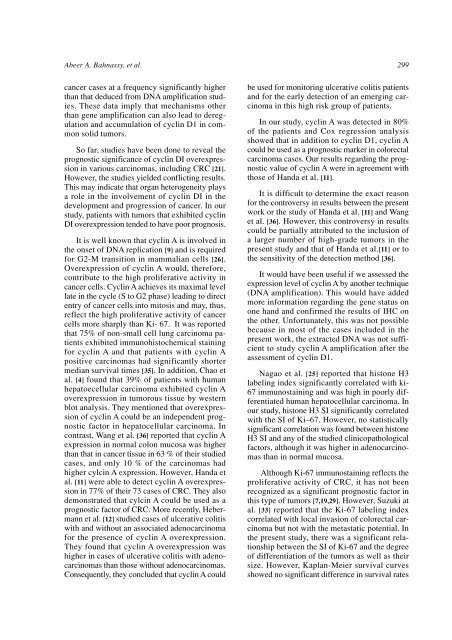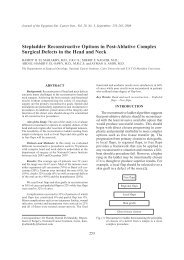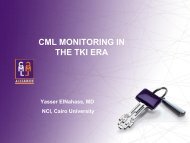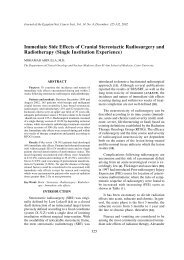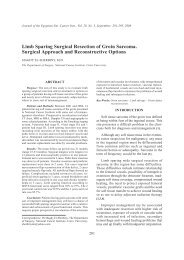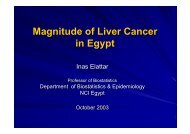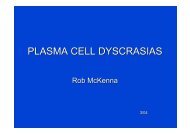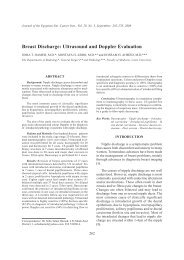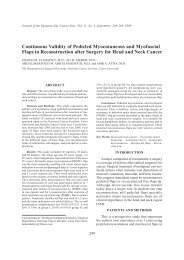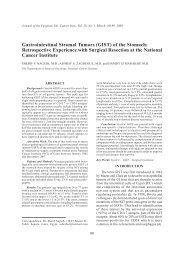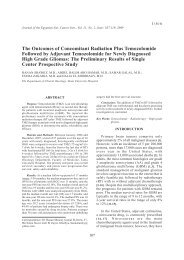Full text - PDF - The National Cancer Institute
Full text - PDF - The National Cancer Institute
Full text - PDF - The National Cancer Institute
Create successful ePaper yourself
Turn your PDF publications into a flip-book with our unique Google optimized e-Paper software.
Abeer A. Bahnassy, et al. 299cancer cases at a frequency significantly higherthan that deduced from DNA amplification studies.<strong>The</strong>se data imply that mechanisms otherthan gene amplification can also lead to deregulationand accumulation of cyclin D1 in commonsolid tumors.So far, studies have been done to reveal theprognostic significance of cyclin DI overexpressionin various carcinomas, including CRC [21].However, the studies yielded conflicting results.This may indicate that organ heterogeneity playsa role in the involvement of cyclin DI in thedevelopment and progression of cancer. In ourstudy, patients with tumors that exhibited cyclinDI overexpression tended to have poor prognosis.It is well known that cyclin A is involved inthe onset of DNA replication [9] and is requiredfor G2-M transition in mammalian cells [26].Overexpression of cyclin A would, therefore,contribute to the high proliferative activity incancer cells. Cyclin A achieves its maximal levellate in the cycle (S to G2 phase) leading to directentry of cancer cells into mitosis and may, thus,reflect the high proliferative activity of cancercells more sharply than Ki- 67. It was reportedthat 75% of non-small cell lung carcinoma patientsexhibited immunohistochemical stainingfor cyclin A and that patients with cyclin Apositive carcinomas had significantly shortermedian survival times [35]. In addition, Chao etal. [4] found that 39% of patients with humanhepatoecellular carcinoma exhibited cyclin Aoverexpression in tumorous tissue by westernblot analysis. <strong>The</strong>y mentioned that overexpressionof cyclin A could be an independent prognosticfactor in hepatocellular carcinoma. Incontrast, Wang et al. [36] reported that cyclin Aexpression in normal colon mucosa was higherthan that in cancer tissue in 63 % of their studiedcases, and only 10 % of the carcinomas hadhigher cylcin A expression. However, Handa etal. [11] were able to detect cyclin A overexpressionin 77% of their 73 cases of CRC. <strong>The</strong>y alsodemonstrated that cylcin A could be used as aprognostic factor of CRC. More recently, Hebermannet al. [12] studied cases of ulcerative colitiswith and without an associated adenocarcinomafor the presence of cyclin A overexpression.<strong>The</strong>y found that cyclin A overexpression washigher in cases of ulcerative colitis with adenocarcinomasthan those without adenocarcinomas.Consequently, they concluded that cyclin A couldbe used for monitoring ulcerative colitis patientsand for the early detection of an emerging carcinomain this high risk group of patients.In our study, cyclin A was detected in 80%of the patients and Cox regression analysisshowed that in addition to cyclin D1, cyclin Acould be used as a prognostic marker in colorectalcarcinoma cases. Our results regarding the prognosticvalue of cyclin A were in agreement withthose of Handa et al. [11].It is difficult to determine the exact reasonfor the controversy in results between the presentwork or the study of Handa et al. [11] and Wanget al. [36]. However, this controversy in resultscould be partially attributed to the inclusion ofa larger number of high-grade tumors in thepresent study and that of Handa et al.[11] or tothe sensitivity of the detection method [36].It would have been useful if we assessed theexpression level of cyclin A by another technique(DNA amplification). This would have addedmore information regarding the gene status onone hand and confirmed the results of IHC onthe other. Unfortunately, this was not possiblebecause in most of the cases included in thepresent work, the extracted DNA was not sufficientto study cyclin A amplification after theassessment of cyclin D1.Nagao et al. [25] reported that histone H3labeling index significantly correlated with ki-67 immunostaining and was high in poorly differentiatedhuman hepatocellular carcinoma. Inour study, histone H3 SI significantly correlatedwith the SI of Ki–67. However, no statisticallysignificant correlation was found between histoneH3 SI and any of the studied clinicopathologicalfactors, although it was higher in adenocarcinomasthan in normal mucosa.Although Ki-67 immunostaining reflects theproliferative activity of CRC, it has not beenrecognized as a significant prognostic factor inthis type of tumors [7,19,29]. However, Suzuki atal. [33] reported that the Ki-67 labeling indexcorrelated with local invasion of colorectal carcinomabut not with the metastatic potential. Inthe present study, there was a significant relationshipbetween the SI of Ki-67 and the degreeof differentiation of the tumors as well as theirsize. However, Kaplan-Meier survival curvesshowed no significant difference in survival rates


